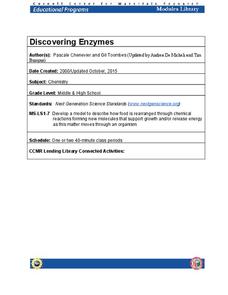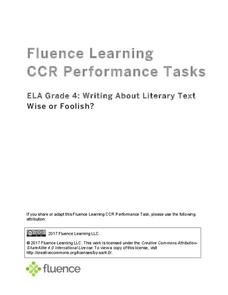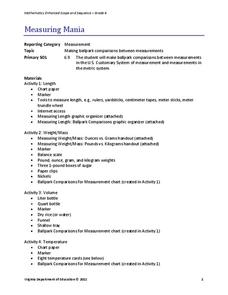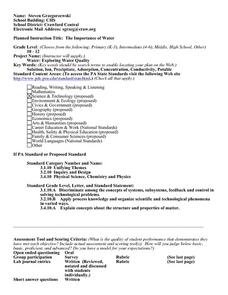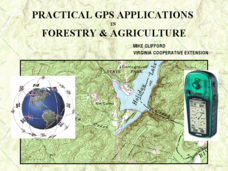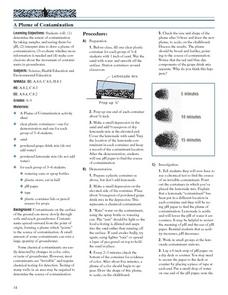University of Georgia
Splat!
What does viscosity have to do with splatter? An activity shows that the viscosity of a substance is inversely proportional to the distance of its splatter. Learners conduct the experiment by collecting data, graphing, and analyzing...
Fluence Learning
Writing About Literature: Comparing and Contrasting Characters in Heidi
Scholars read excerpts from the story, Heidi, in a three-part assessment that focuses on comparing and contrasting characters. Each part contains three tasks that challenge learners to discuss, answer comprehension...
Cornell University
Discovering Enzymes
Explore the function of enzymes through a series of lab investigations. Learners use household enzymes such as hydrogen peroxide to model the role of enzymes. The enzymes break down proteins with and without a catalyst.
Fluence Learning
Writing About Literary Text: Wise or Foolish?
A three-part assessment promotes reading comprehension skills. Class members read literary texts and take notes to discuss their findings, answer comprehension questions, write summaries, and complete charts.
Illustrative Mathematics
Satellite
Learners practice relating rules of trigonometry and properties of circles. With a few simplifying assumptions such as a perfectly round earth, young mathematicians calculate the lengths of various paths between satellite and...
Virginia Department of Education
Measuring Mania
Conversion immersion — it's measuring mania! A set of four activities teaches scholars to convert between customary and metric units. Resource covers unit conversions in length, temperature, weight/mass, and volume.
Virginia Department of Education
Logic and Conditional Statements
If there is a conditional statement, then there is a hypothesis and conclusion. Pupils learn how to identify the parts of conditional statements. Class members continue to work with conditional statements and rewrite them in their many...
Lee & Low Books
Classroom Guide for Sacred Mountain: Everest
The most famous climbers of Mount Everest could never have made it to the summit without the assistance of the local Sherpa. Christine Taylor-Butler's nonfiction children's book Sacred Mountain: Everest is the focus of an extensive...
Curated OER
As the Sun Burns
Students test commercial sunscreens or sunglasses for accuracy of their Sun Protection Factor. They devise a method for testing UV beads with a visual clues which they publish as research. They investigate occupations such as...
Curated OER
Rockets on a Shoestring Budgut
Young scholars work together to create rockets on a budget. They discover the limitations that real engineers face when designing and testing their products. They discuss their findings to complete the lesson.
Curated OER
How To Get Clear On Water
Tenth graders investigate different systems that are used to purify water. They have class discussion about the benefits and challenges that different countries would face with the implementation of the systems. Students explain the...
Curated OER
FAT FOLLIES
Middle schoolers, testing various foods for fat content by rubbing food samples on paper. Students identify what and who the US Food and Drug Administration is in reference to the Food Pyramid. Middle schoolers write the name of each...
Curated OER
Museum Adventure WebQuest
Students discover the background and properties of minerals. They examine fluorite and record data after testing it. They use the internet to help them discover information about minerals.
Curated OER
Why Does the Bulb Light When There is Flow?
Young scholars analyze light bulbs and their design. They create filaments and build a circuit for testing the filaments. Through experimentation, students discover how filament wire works. They explore the role of protons, electrons,...
Curated OER
LearningCheck State Proactice Exams Item Banks
Students examine state practice test exams questions. In this secondary mathematics exam, students receive instructions for downloading state practice exams, using the test item banks with the TI-Navigator system, and view sample...
Curated OER
The Importance of Water
Young scholars explore the importance of water. They discuss why water is important and students design an experiment that evaluates the water quality and methods of improving water quality. Young scholars perform testing and report...
Curated OER
Acid Rain
Learners identify the causes and effects of acid rain. Using the internet, they research pollution sources in their local area and by collecting rain samples and testing the pH. In groups, they develop their own plan urging local...
Curated OER
Build Your Own Greenhouse
Students study how to protect themselves and their things from the harsh Arctic weather by making a small greenhouse and testing its effects on temperature change. They discover the change in temperature between a thermometer inside the...
Curated OER
Water Quality
Students play the role of scientists testing for water quality in the area. In this ecology lesson, students determine the water sample's pH, temperature, dissolved oxygen and turbidity. They write a journal reflection after the activity.
Curated OER
How a Circuit Works
Students discover the basic principles of circuits by designing and testing some of their own. They are told that circuits usually have a power source such as a battery and a resistor such as a light. Students make a circuit using a...
Curated OER
Testing Carving Tools
Learners onstruct an ancient bow drill and compare its effectiveness at carving stone to marks made by other tools. They perform a careful analysis of the performance of each tool.
Curated OER
Particulate Matter: How Dirty is the Air We Breathe?
Fourth graders create a simple testing device and collect and observe the pollution in the air we breathe.
Curated OER
Practical GPS Applications in Forestry & Agriculture
An explanation of the Global Positioning System (GPS) and the Geographic Information System (GIS) is given in this presentation. Uses and applications are considered. How it works and sources of error are also touched upon. A large...
Curated OER
A Plume of Contamination
Pupils perform an experiment/investigative simulation regarding the movement of contaminants in groundwater. They test the pH of three water samples, and then use their reasoning skills to determine the source of an invisible...




